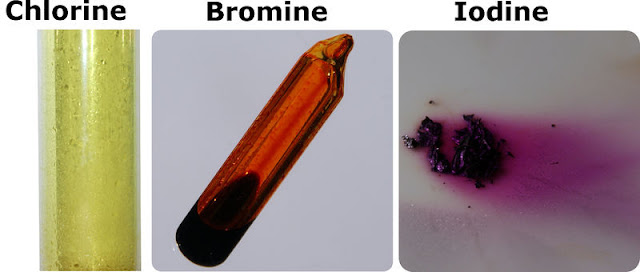New OCR Gateway specification from September
2016 Higher tier: grades 9 to 4:
In this and subsequent posts I’m simply going to explain and illustrate each learning objective as they come up in the topics in the new GCSE specification.
I’m giving you my notes from each lesson.
You can really get ahead of your class if you follow this blog and all the posts that will appear here about the new GCSEs over the coming months.
This rejigging of the specification is just that: there is nothing really new here it has all been with us for the past half century at least.
And remember all that’s written in italics is for the higher tier paper only.
 You can find a two
minute explanation of how to build the electron structures from atomic numbers from
Youtube here
You can find a two
minute explanation of how to build the electron structures from atomic numbers from
Youtube here
In this and subsequent posts I’m simply going to explain and illustrate each learning objective as they come up in the topics in the new GCSE specification.
I’m giving you my notes from each lesson.
You can really get ahead of your class if you follow this blog and all the posts that will appear here about the new GCSEs over the coming months.
This rejigging of the specification is just that: there is nothing really new here it has all been with us for the past half century at least.
And remember all that’s written in italics is for the higher tier paper only.
C2
Elements, Mixtures and Compounds
C2.2
Bonding
C2.2a
describe metals and non-metals and explain the differences between them on the
basis of their characteristic physical and chemical properties i.e. the formation of ions and common reactions, e.g. with oxygen to form
oxides
Physical properties of
metals and non-metals:
Metals:
Property Explanation Example
Sonorous They clang when hit Brass
Hard No pressure leaves an
impression Osmium
Ductile Can be stretched into thin wires Gold
Malleable Can be beaten in to flat sheets Gold
Reflective Can reflect light to form a mirror Silver
Metals are also
usually solid at rtp, silver coloured with high melting and boiling points.
Non-metals:
Non-metals tend to be
soft e.g. sulphur, coloured e.g. red phosphorus and liquid e.g. bromine or gas
e.g. noble gases at room temperature.
Metalloids:
These are elements
between metals and non-metals in the Periodic Table. They tend to have both metallic and
non-metallic properties.
Chemical properties
Formation of ions
Metals lose up to
three electrons from their atoms to leave full outer shells and so form
positive ions or cations.
Non-metals gain up to
three electrons into their atoms to fill the outer shell and so form negatively
charged ions or anions.
Non-metals also
combine with other non-metals to form radical ions. Radical ions can be positively or negatively
charged.
Examples of radical
ions are sulphate SO4 2–, nitrate NO3 –,
and carbonate CO3 2–
Metals and non-metals
both combine chemically with oxygen to form oxides.
Metal oxides are
generally basic and if soluble in water they are also alkaline.
1) Magnesium
2Mg
+ O2 =
2MgO
Magnesium burns in
oxygen with a very bright white flame.
Magnesium oxide is
slightly soluble in water, the magnesium hydroxide solution formed is slightly
alkaline about pH 8.
MgO +
H2O = Mg(OH)2
2) Copper
2Cu + O2
= 2CuO
Copper turns black
when heated in air the black oxide coating on the metal is insoluble in water
but dissolves in hot sulphuric acid to form blue copper sulphate solution.
CuO + H2SO4 =
CuSO4 + H2O
Non-metal oxides tend
to be soluble in water and generally form acidic solutions.
1) Sulphur
S + O2 = SO2
Sulphur burns with a
blue flame in air or oxygen produces dense fumes that are soluble in water and
leave a solution of sulphurous (sulphur(IV)) acid pH2.
SO2 + H2O = H2SO3
2) Carbon
C + O2 = CO2
Hot carbon powder
ignites with orange sparks in pure oxygen the carbon dioxide forms dissolves in
water to give a very weakly acidic solution pH6.
C2.2b
explain how the atomic structure of metals and non-metals relates to their
position in the periodic table
Metals are found on
the left of the periodic table and non-metals on the right hand side as in the
diagram below:
The reason is that
metals tend to have three or less electrons in their outer shells whereas
non-metals tend to have four or more electrons in their outer shells.
There are exceptions
to this:
1) Hydrogen with one
electron and helium with two electrons in its outer shell are both non-metals.
2) Going down a group
of non-metals in the periodic table the elements become more metallic e.g.
Group 4 (14) goes from carbon (C) to lead (Pb).
C2.2c
explain how the position of an element in the periodic table is related to the
arrangement of electrons in its atoms and hence to its atomic number
You can find the
position of an element in the Periodic Table of the first 20 elements if you
know its atomic number.
Let’s think about the
element where atomic number Z=15.
Z=15 means 15 protons
in the nucleus and 15 electrons in shells.
The first shell only
contains two electrons, the second eight so the electron arrangement of Z=15
must be 2)8)5.
Therefore, with three
shells the element is in Period 3 (Row 3).
With 5 electrons in
its outer shell the element is in Group 5 (15).
So the element is Phosphorus
P.
In the shortened Periodic Table below Hydrogen (H) is missing but the diagram is still useful, I think.
 You can find a two
minute explanation of how to build the electron structures from atomic numbers from
Youtube here
You can find a two
minute explanation of how to build the electron structures from atomic numbers from
Youtube here 




















No comments:
Post a Comment